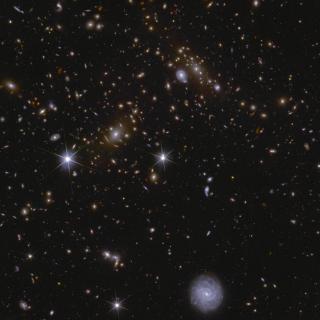It may interest you
-
 The Solar System research group at the Instituto de Astrofísica de Canarias (IAC) is participating in the international programme to keep a closet track of asteroid 2024 YR4. The aim is to determine its orbit with the highest possible precision before it stops being observable by ground based and satellite telescopes in April, and so improving our value of the probability that it will impact the Earth in 2032. In this context several telescopes of the Canary Observatories of the IAC are playing an outstanding role in this observing campaign: The Gran Telescopio Canarias (GTC) at the Roque deAdvertised on
The Solar System research group at the Instituto de Astrofísica de Canarias (IAC) is participating in the international programme to keep a closet track of asteroid 2024 YR4. The aim is to determine its orbit with the highest possible precision before it stops being observable by ground based and satellite telescopes in April, and so improving our value of the probability that it will impact the Earth in 2032. In this context several telescopes of the Canary Observatories of the IAC are playing an outstanding role in this observing campaign: The Gran Telescopio Canarias (GTC) at the Roque deAdvertised on -
 The Vera C. Rubin Observatory, located in Chile, today released its first images of the universe, known in astronomy as an instrument's “first light”. This event marks the beginning of a project that will revolutionise our understanding of the universe over the next decade. Jointly funded by the US National Science Foundation (NSF) and the US Department of Energy (DOE), the Instituto de Astrofísica de Canarias (IAC) is participating, as part of a consortium of Spanish institutions, in its scientific exploitation and contributing observation time from the Gran Telescopio Canarias (GTC orAdvertised on
The Vera C. Rubin Observatory, located in Chile, today released its first images of the universe, known in astronomy as an instrument's “first light”. This event marks the beginning of a project that will revolutionise our understanding of the universe over the next decade. Jointly funded by the US National Science Foundation (NSF) and the US Department of Energy (DOE), the Instituto de Astrofísica de Canarias (IAC) is participating, as part of a consortium of Spanish institutions, in its scientific exploitation and contributing observation time from the Gran Telescopio Canarias (GTC orAdvertised on -
 The European Space Agency’s Euclid mission released its first batch of survey data, including a preview of its deep fields. Using Artificial Intelligence (AI) algorithms in combination with citizen science campaigns, the Euclid Consortium scientific results include the discovery of strong gravitational lensing systems, the exploration of galaxy clusters and the cosmic web, the characterisation of active galactic nuclei (AGN) and quasars, studies on galaxy evolution and morphology, and the identification of numerous dwarf galaxies and transients. Spain has an important role in the EuclidAdvertised on
The European Space Agency’s Euclid mission released its first batch of survey data, including a preview of its deep fields. Using Artificial Intelligence (AI) algorithms in combination with citizen science campaigns, the Euclid Consortium scientific results include the discovery of strong gravitational lensing systems, the exploration of galaxy clusters and the cosmic web, the characterisation of active galactic nuclei (AGN) and quasars, studies on galaxy evolution and morphology, and the identification of numerous dwarf galaxies and transients. Spain has an important role in the EuclidAdvertised on

